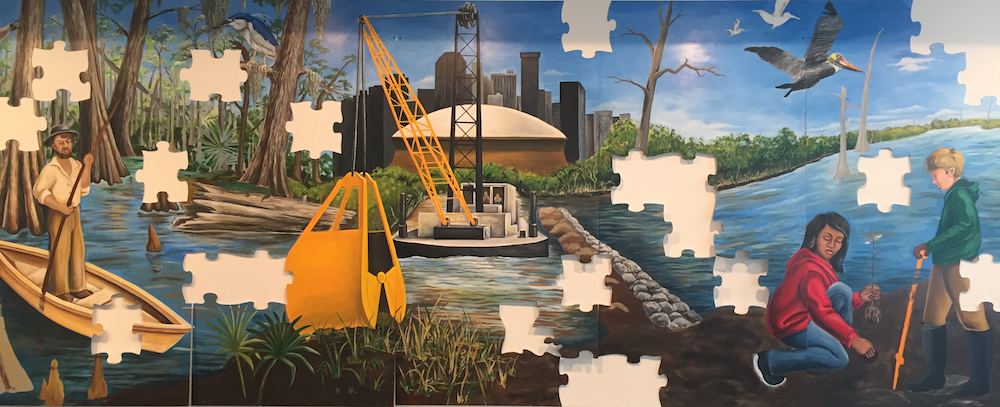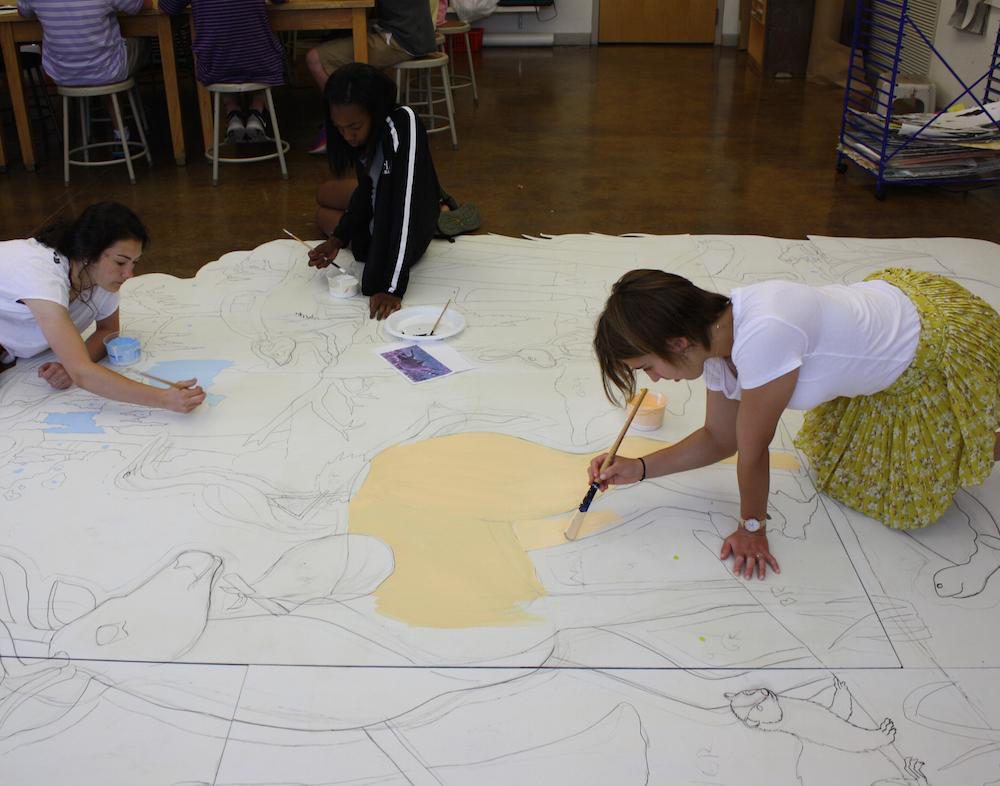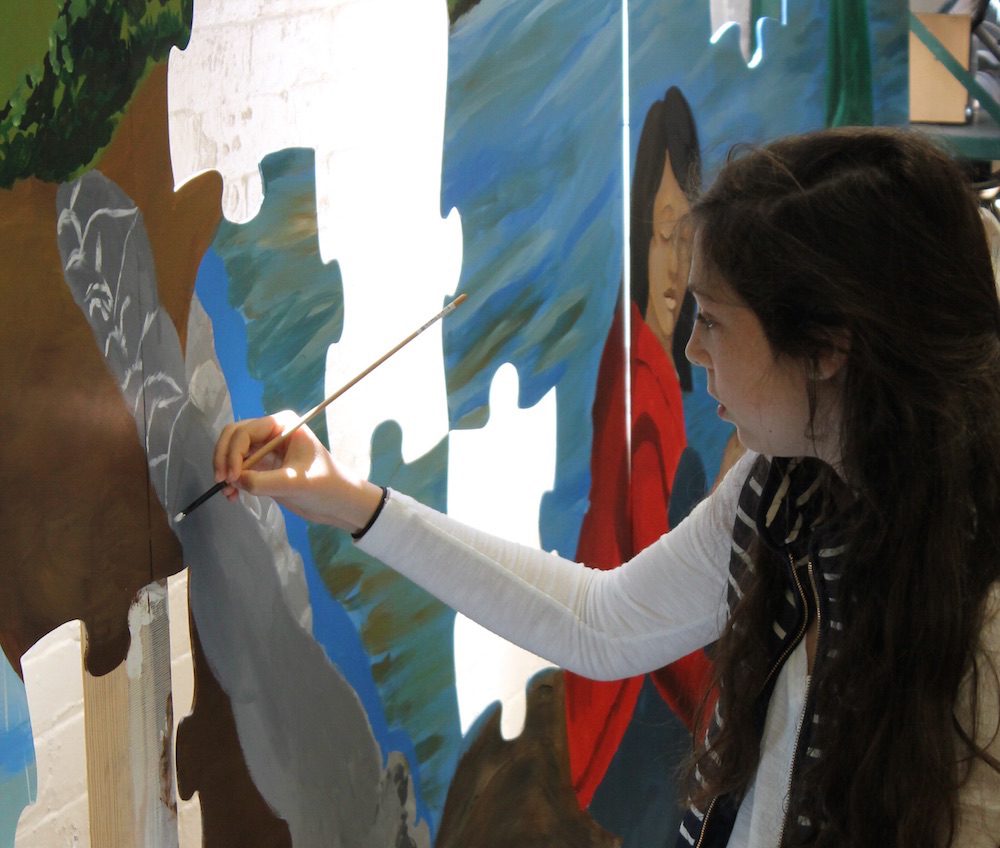Budding Advocates: Young Muralists at Isidore Newman School
Benjamin Morris visits Isidore Newman School and introduces us to a student-driven mural project about Louisiana’s wetlands.

Photo of the completed mural designed and executed by high school students at Isidore Newman School. courtesy Isidore Newman School, New Orleans.
With its plight an ongoing source of news, Louisiana’s wetlands have rallied a range of defenders over the years, from policymakers to attorneys to coastal restoration experts. With a new exhibition opening at Isidore Newman School next week, however, advocates can add one more group to their list: area secondary students. Over the past few months, middle and high school students at Newman have designed and constructed two full-size murals that are intended both to draw attention to the issues surrounding the wetlands and to enter into the city’s catalogue of public art.
Designed under the tutelage of New Orleans-based muralist Max Bernardi, currently the Friedler Family Artist-in-Residence at Newman, the murals grew out of a series of trips into the wetlands over the course of the past year. These trips, curated by Lost Lands Tours and guided by coastal restoration experts such as journalist Bob Marshall, brought middle and upper school art students directly into the affected areas to witness their beauty and their degradation firsthand. Documenting the decline due to coastal erosion and petrochemical development, students brought what they saw immediately back to the classroom and set to work.
For many students, notes Andrew Rodgers, chair of the art department at Newman, these trips were their first direct contact with the wetlands—despite being locals. “I think there’s an assumption just looking at socioeconomics that some students in the New Orleans area would have contact with the wetlands and others wouldn’t. I don’t think we can assume that. The truth is, many of us haven’t yet fully reckoned with the fact that we here are a coastal community—our students had no idea that the wetlands, just 15 minutes away, were so close.”

Photo of middle school students working on the draft of their mural. Courtesy Isidore Newman School, New Orleans.
Following the design and drafting stages, which began in February, the execution took two months. Painted in bold, bright colors on a series of panels as tall as they are wide, the middle school mural depicts iconic Louisiana wildlife—ducks, raccoons, marsh hares, alligators—migrating from one side of the panels to another, departing the deteriorated wetlands for a healthier and more verdant ecosystem. In a gesture of kinship with the animals, the students have depicted each species carrying a small backpack or bag. At once charming and moving, the overall concern is evident: without intervention, we too may be packing our bags one day.
The upper school mural—expectedly more sophisticated in execution—consists of five panels, whose content yields a kind of triptych of Louisiana history, from the area’s pioneer days at the left (whose scenes were adapted from photographs taken by students on the trips), to the age of modern development in the center, to its gesture towards future restoration at the right. The mural is meant to be read in sequence. Inspired by the narrative murals of the WPA era, the cycle of discovery, exploitation, and regeneration tracks the past three centuries of settlement in this area. In a nod to the next generation, the two young children depicted planting cypress trees are modeled after real-life Newman elementary students.
Rather than gloss over the impacts that development of coastal lands has entailed, however, the students’ mural foregrounds them in multiple ways. Most immediate are the missing pieces of the mural—its title is Disappearances—which have been cut out of the panels to form ghostly gaps where native and endangered wildlife such as mink and egrets should be. Forming literal missing pieces of the puzzle, one of which has the outline of the state itself, these absences offer a grim reminder of the impacts of human activities in the wetlands. Similarly, using a powerful distortion of perspective in the center panel, the students have depicted the New Orleans skyline, in particular the Superdome, as encroaching within inches of the coastal zone.
The warning couldn’t be more clear. That said, the one aspect that the students have equally sought to foreground is hope: in both instances, the murals tend towards an optimistic future, one in which green replaces brown, and growth replaces decline. With animals working together in one mural, and humans collaborating in the other, such partnerships are a perfectly tender metaphor for the task at hand.

Photo of a high school student painting at Isidore Newman School. Courtesy Isidore Newman School, New Orleans.
Editor's Note
“Disappearances” opens on Wednesday, April 29, 5:30-7:30pm at the Reynolds Ryan Art Gallery at Isidore Newman School (5333 Danneel Street). The murals will remain in the gallery until May 27, after which they will be mounted in their permanent locations on campus. Members of the public should contact the school to schedule a visit.
Continue learning more about wetlands advocacy and artists' responses during the Second Annual Wetlands Art Tour taking place on Saturday, May 9.



